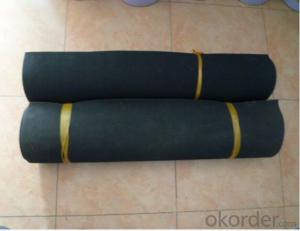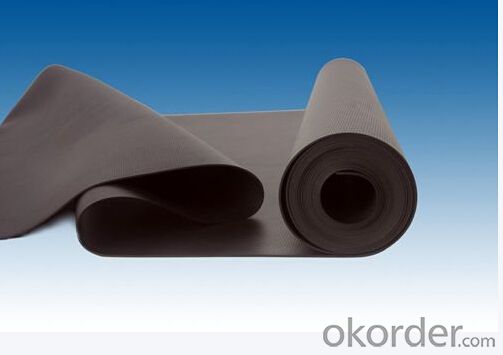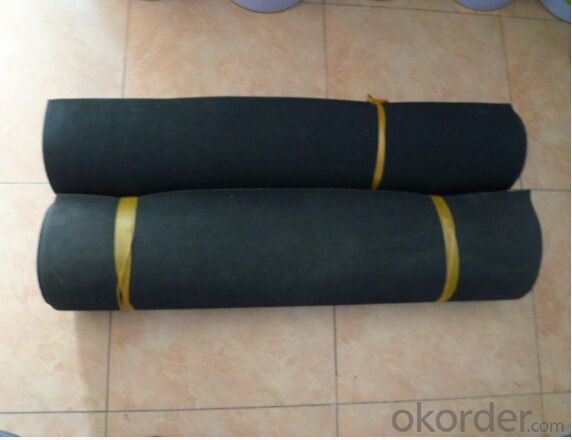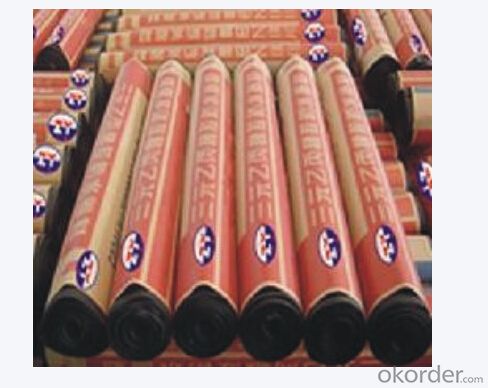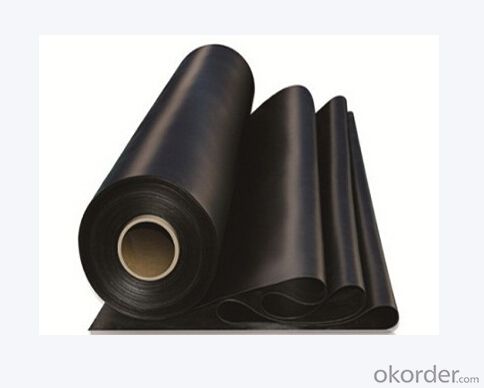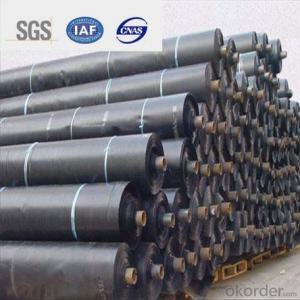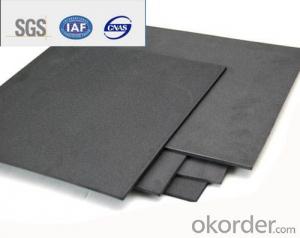EPDM Waterproofing Membrane Width 1.2m to 4m Used for Roof/Pond Liner/Basement
- Loading Port:
- Qingdao
- Payment Terms:
- TT or LC
- Min Order Qty:
- 2000 m²
- Supply Capability:
- 200000 m²/month
OKorder Service Pledge
OKorder Financial Service
You Might Also Like
EPDM waterproofing Membrane
1. Main Introudction:
EPDM Waterproofing Memebrane has high elasticity with best performance among high polumer waterproof coiled material in the world.
It is also the most typical one in the world.
Waterproof coiled material made of ternary ethylene propylene rubber is produced with the use of the most advanced contiuous extrusion and vulcanization technology and related equipments which are specially designed for production of such product.It is good in compactness,
without bubble and performance difference in length and breadth,perfomances reach or exceed the demands of GB18173.1-2000 standard.
2. Main Features:
1>Excellent antiaging performance, service life up to 50 years
2>Working well with in 40C to 100C,it canbe constructed with a single layer in ambient temperature.
3>Waterproofing on various kinds of underground project,industrial of civil buildings and structures.
4>high extension rate, high tensile strength, small size changes at heat treatment
5>Good plant roots penetrability resistance and can be made waterproofing layer of planting roof
6>Special modified molecular structure ,effectively resolving the current domestic and foreign glue joint problem .
7>Good low temperature flexibility, and good performance of adapting to ambient temperature changes.
8>Convenient application ,solid joint, no environment pollution
9>chemical corrosion Resistance, can be used for special occasions
10>Convenient maitenance, low cost.
3. Main Application:
Widely used in roofs, basement, toilet ,swimming pool, and all kinds of industry and civil building
waterproofing, reservoir, vivicism, bridge, underground, tunnel and dam waterproofing ,especially
to the keystone waterproofing projects which is durability, high corrosion resistance and easy
deformation
4. Specification:
Type | EPDM Waterproof Membrane | |||
Material | EPDM Rubber | |||
Thickness | 1.0mm | 1.2mm | 1.5mm | 2.0mm |
Size | 1.2m(width) * 20m(length)/roll | |||
Type | Vulcanized | |||
Pattern | Non-reinforced(homogeneous) | |||
Packing | 24sqm--80sqm/roll, with plastic bag | |||
Color | Black | |||
Application | Roofs, basement, pond, Lake, steel structure roof, swimming pool, underground, tunnel, etc | |||
5. Some photos:
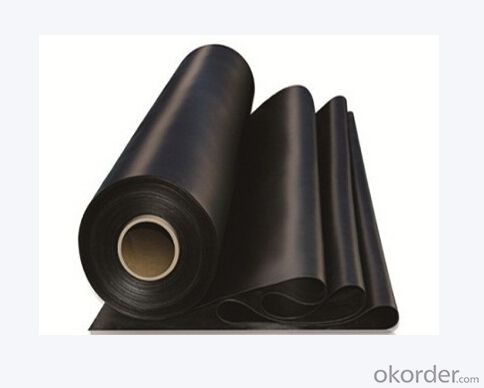
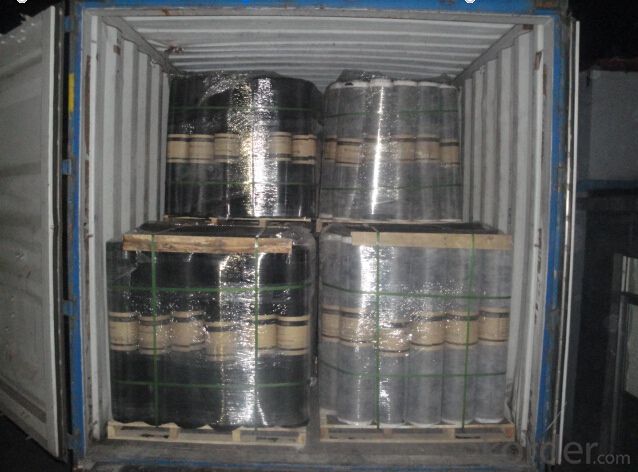
6. RFQ:
What's your payment terms?
T/T or L/C at sight is accepted
What's your package?
One roll with one woven bag, and several rolls in one pallet
What's your delivery time?
Within one week after deposit received
- Q: Can a waterproofing membrane be used for solar panel installations?
- Yes, a waterproofing membrane can be used for solar panel installations. In fact, it is often recommended to use a waterproofing membrane as part of the installation process to protect the roof or other surfaces beneath the solar panels from water damage. A waterproofing membrane acts as a barrier to prevent water from seeping into the underlying structure, ensuring that the solar panel installation remains watertight and secure. This is particularly important as solar panels are typically installed on rooftops, where they are exposed to various weather conditions. By incorporating a waterproofing membrane, it helps to prolong the lifespan of the solar panels and prevents any potential water-related issues that could affect their performance.
- Q: Can a waterproofing membrane be used on precast brick block surfaces?
- Precast brick block surfaces can indeed benefit from the application of a waterproofing membrane. Such a membrane serves as a protective shield, safeguarding the bricks against water infiltration, which could otherwise lead to undesirable consequences like cracks, efflorescence, or the growth of mold. It is crucial to select a waterproofing membrane explicitly designed for masonry surfaces, as these membranes are specially formulated to adhere perfectly to the distinct properties of brick and block materials. Moreover, to guarantee the membrane's effectiveness, it is essential to adhere to proper surface preparation and application techniques.
- Q: What are the requirements for the storage of waterproofing membranes?
- Prohibited sun exposure, exposure easily deformed.
- Q: Can a waterproofing membrane be used for a plaza deck waterproofing?
- Yes, a waterproofing membrane can be used for plaza deck waterproofing. Plaza decks are typically exposed to the elements, including rain and snow, and require a waterproofing system to prevent water infiltration and potential damage to the structure below. Waterproofing membranes are designed specifically for this purpose, offering a barrier against water and protecting the deck from moisture-related issues such as leaks, deterioration, and mold growth. These membranes are typically made from materials such as bitumen, PVC, or EPDM, and are applied in multiple layers to ensure a durable and watertight seal. By using a waterproofing membrane, plaza decks can effectively maintain their structural integrity and longevity.
- Q: Can a waterproofing membrane be used for foundation repair?
- Yes, a waterproofing membrane can be used for foundation repair. Waterproofing membranes are commonly used to prevent water intrusion and can be applied to foundation walls to seal any existing cracks or gaps, preventing further damage or leaks. Additionally, they can help improve the overall strength and durability of the foundation, providing long-lasting protection against water damage.
- Q: Are waterproofing membranes resistant to salt damage?
- Waterproofing membranes are generally resistant to salt damage, as they are specifically designed to create a barrier against moisture and water infiltration, offering protection against saltwater as well. Saltwater can be highly corrosive and cause harm to different materials, but waterproofing membranes are typically constructed using materials that can withstand the corrosive effects of salt. These membranes often consist of reinforced PVC, modified bitumen, or EPDM rubber, all of which have proven their durability and reliability in saltwater environments. In fact, waterproofing membranes are commonly used in areas like basements, swimming pools, and marine structures, where they are regularly exposed to saltwater. Thus, it can be concluded that waterproofing membranes are generally resistant to salt damage and effectively shield against saltwater infiltration.
- Q: Can a waterproofing membrane be used for an industrial facility floor?
- Yes, a waterproofing membrane can be used for an industrial facility floor. Waterproofing membranes are commonly used in industrial settings to protect floors from water damage and to prevent moisture from seeping into the concrete or substrate. These membranes are designed to create a seamless and impermeable barrier that can withstand heavy foot traffic, industrial equipment, and chemical spills. They can also provide additional benefits such as resistance to mold and mildew growth, increased durability, and easier maintenance. However, it is important to choose a waterproofing membrane that is specifically designed for industrial applications and to follow the manufacturer's instructions for proper installation and maintenance.
- Q: What is the PEDM waterproofing membrane material?
- Process: clean up the grassroots → brushing the primary treatment agent → additional layer of treatment → film paste surface coating → base surface coating → coil bonding, exhaust, compaction → coil joint bonding, compaction → roll Material end of the head and edge processing → do protection.
- Q: Asphalt waterproofing membrane and polymer waterproofing membrane
- It is a kind of self-adhesive polymer with self-adhesive function, such as butyl rubber and anti-sticking layer, which can be compounded with a certain thickness of the modified asphalt waterproofing membrane. Modified asphalt waterproofing membrane.
- Q: Is a waterproofing membrane resistant to mold and mildew growth?
- Indeed, the resistance of a waterproofing membrane to the growth of mold and mildew stems from its specific design, which aims to establish a barrier against moisture infiltration. This impedes water seepage and the subsequent development of mold and mildew. Through the effective sealing of the area, these membranes eradicate the favorable conditions for the proliferation of mold and mildew, such as dampness and moisture. However, it is important to acknowledge that although the membrane itself exhibits resistance to mold and mildew growth, it does not guarantee absolute protection against these issues. Proper installation, regular maintenance, and ensuring adequate ventilation play pivotal roles in preventing the long-term growth of mold and mildew.
Send your message to us
EPDM Waterproofing Membrane Width 1.2m to 4m Used for Roof/Pond Liner/Basement
- Loading Port:
- Qingdao
- Payment Terms:
- TT or LC
- Min Order Qty:
- 2000 m²
- Supply Capability:
- 200000 m²/month
OKorder Service Pledge
OKorder Financial Service
Similar products
Hot products
Hot Searches
Related keywords


